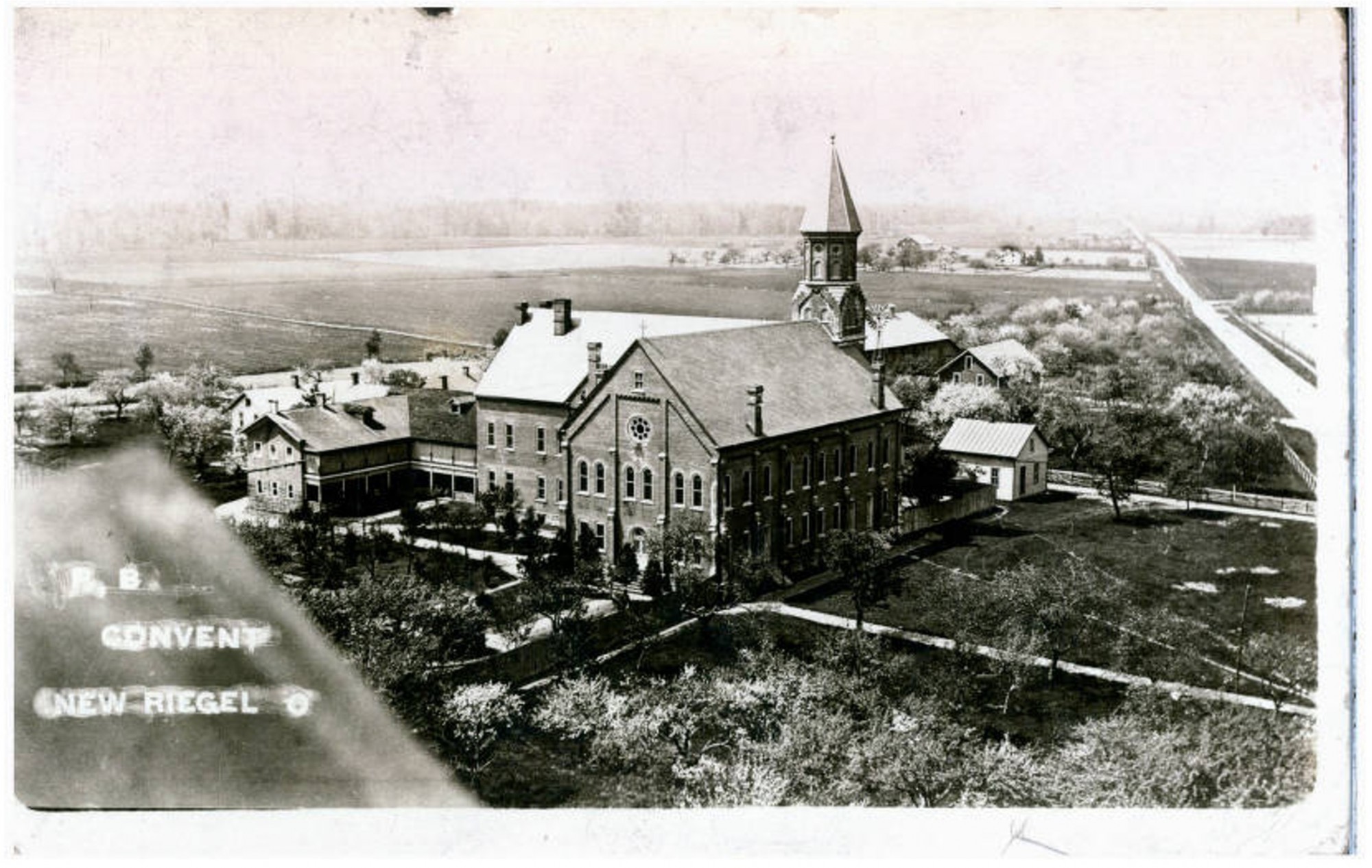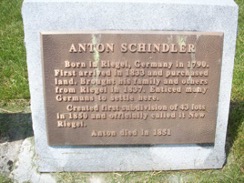
Secrets of Seneca County Historical Driving Tour | St. Boniface Church, Convent, and Anton Schindler
Embark on a captivating journey through the wondrous past of Seneca County, Ohio, with the Secrets of Seneca County Historical Driving Tour! The next stop on the journey is: St. Boniface Church, Convent, and Anton Schindler (New Riegel, OH, Stop #3)
The first Catholic masses held at Wolf Creek (the area currently known as New Riegel) were in the log cabin home of Anton Schindler in 1834. In 1836, Anton Schindler sold three acres of land to the newly created St. Boniface Parish. A log cabin church was built, and mass held by a Redemptorist Priest, Father Tschenhenns. In 1839, three additional acres were purchased from Stephen Brosemer.
In 1844, Father Francis de Sales Brunner of the ‘Congregation of the Most Precious Blood Order’ visited the Wolf Creek community. A men’s community was planned. However, in August of 1844 it was decided that upon completion, the buildings would be turned over to the Precious Blood Sisters. This included a convent, school, and a chapel. On December 22, 1844, the convent was completed, and six sisters took up residence and dedicated their chapel to ‘Mary at the Crib’. The Sisters opened a day school and asylum for orphan girls at their convent. It was the first convent and the first Catholic orphanage established in northern Ohio. The priest and brothers later built a two-story brick U-shaped residence for themselves across the street in 1845. It stood until 1905, when the current priests’ residence replaced it.

A brick church was built in 1845, but only lasted 30 years due to poor quality bricks. In 1878, the church we now see in New Riegel was completed. It was dedicated to Saint Boniface, the patron saint of Germany, where many community members emigrated from. It has seen several renovations over its nearly 150-year history, including changes to the steeple in 1936. At its largest, the Brothers & Sisters of the Order of the Precious Blood owned 220 acres and cultivated farms that made them self-sustaining. St. Boniface was one of the larger parishes in this part of the State. The priests who were stationed here would travel among several counties to celebrate Mass and administer sacraments. They traveled on horseback or on foot to Tiffin St. Joseph, St. Andrew in Liberty Township, St. Peter in Upper Sandusky, St. John in McCutchenville, St. Wendelin in Rome (aka Fostoria), St. Michael in Findlay, St. Joseph in Crawfordville, St. Nicholas in Frenchtown, Ss. Peter and Paul in Alvada, and St. Mary in Kirby.
In 1894, a larger brick chapel/convent was built for the Sisters of the Precious Blood. In 1927, the parish built a new brick school with increased capacity. The sisters taught at the school until 1979 when the convent was closed and sold to a local residence who maintained it as a group home for elderly veteran. On June 26, 2001, the former convent building was destroyed by a fire. The grounds remain in private ownership. The school building continued to be used but operated as a public school until January 2003, when the New Riegel School District completed construction on a new building across the street on land which was once owned, logged, and farmed by the Order of the Precious Blood.
 Renamed as All Saints Parish in 2005, the parish has merged with the former parishes of St. Nicholas (Berwick/Frenchtown), Ss. Peter and Paul (Alvada), St. Andrew (Liberty Township), St. Patrick (Bascom), and St. James (Kansas). The churches of the former parishes have all been demolished. The St. Boniface church built in 1875 is the only one that survives.
Renamed as All Saints Parish in 2005, the parish has merged with the former parishes of St. Nicholas (Berwick/Frenchtown), Ss. Peter and Paul (Alvada), St. Andrew (Liberty Township), St. Patrick (Bascom), and St. James (Kansas). The churches of the former parishes have all been demolished. The St. Boniface church built in 1875 is the only one that survives.
Anton Schindler was a prosperous farmer and great community leader during his time. He sold 3 acres of land, in 1836, for the original log cabin church to be constructed on. He also plotted the Village of New Riegel in 1850. Sadly, he passed away in 1851 from cholera, and was laid to rest in the St. Boniface cemetery. Anton’s family moved to Minnesota likely out of fear of the repeated cholera outbreaks. Only his daughter Magdalena remained in New Riegel. She is laid to rest next to her father. A unique marker can be found behind the Cemetery Chapel, which was laid by his great-great nephews. The marker is in the original section of the cemetery, which dates to the beginning of the parish in 1836. Many of the headstones in this original area have been lost to time.

Get Your Free Copy!
DOWNLOAD THE GUIDE »
Follow us:

Tiffin, Ohio 44883
Friday: 8AM - 3PM

